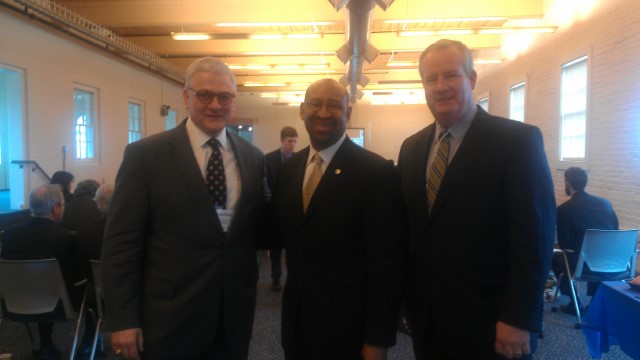How to Bridge the Gap between Utility Companies and Building Owners
Policy effort led by Laurie Actman, former Deputy Director of the Energy Efficient Buildings Hub
Introduction
Knowledge is power when it comes to improving energy efficiency in buildings. Yet, building owners and facility managers of commercial properties are not always privy to information about their buildings’ energy consumption. Rather, their tenants – the utility companies’ direct customers – are the custodians of that data. In most metropolitan areas, an individual tenant’s energy usage is private information – a tenant may voluntarily choose to share that information with the facility manager, but procedures for doing so are developed on an ad-hoc basis and vary from building to building, making systematic comparison difficult.

Forging partnersips. Left to right – Henry C. Foley, former CBEI Director; The Honorable Michael Nutter, Mayor of Philadelphia; and Roberty Powelson, Chairman of the Pennsylvania Utility Commission
In response to this challenge, public utilities, large commercial building owners, and local legislators have made a concerted effort to establish laws that facilitate the public disclosure of energy use information, while respecting the privacy rights of individual energy consumers. Philadelphia recently joined the club by mandating in June 2012 the benchmarking and disclosure of the energy performance of commercial buildings over 50,000 square feet. The EEB Hub is now assisting the largest local utility, PECO – which serves all of Philadelphia and Delaware Counties as well as portions of Montgomery, Chester, and Bucks Counties – to set up a new data access program to make it easy for commercial building owners to comply with the new law. Part of the EEB Hub’s approach is to instigate conversations between Philadelphia’s utilities and organizations with model programs in other metropolitan areas.
The Value of Benchmarking Data

Data Working Group meeting. Source: CBEI
The value of simplifying access to utility energy data stems from that data’s application in benchmarking, the act of measuring the energy performance of a building over time so that its performance can be compared to a norm or to a group of peers [1]. Benchmarking gives building owners a basis of comparison and the information they need to understand how their buildings’ energy use stacks up. In an information vacuum, there is no way to know if a building’s energy performance is meeting its potential or falling short.
To facilitate building benchmarking, the U.S. Environmental Protection Agency (EPA) has established Portfolio Manager, an interactive energy management tool for building owners to track securely water and energy consumption across a portfolio of buildings. Energy Star – an international program for energy efficient consumer products, which was jointly founded by the EPA and the U.S. Department of Energy (DOE) in 1992 – oversees Portfolio Manager. As such, Energy Star rates buildings that provide data to the system. From 2008-2011, the EPA analyzed 36,000 buildings that went through this process and discovered that they achieved an average annual energy savings of 2.4% by virtue of their ability to benchmark [2]. A survey by the trade publication Building Operations Management underscored the value of the Energy Star program, noting that more than 70% of the several hundred facility managers surveyed benefitted from Energy Star ratings in their efforts to plan upgrades, while 67% justified an energy efficiency project by citing their rating [3]. Currently, about 40% of the commercial building square footage in the U.S. has its energy consumption information submitted to Portfolio Manager.

Data Working Group speakers. Source: CBEI
Utility companies – prompted to provide energy savings programs by legislation (such as PA Act 129, a state energy conservation bill) and by a need for demand reliability and energy security – also benefit from benchmarking. By empowering building owners, a benchmarking program can be a gateway to utilities’ other energy efficiency programs. Benchmarking scores can also be used to analyze the effectiveness of programs offered by a utility [4]. Moreover, benchmarking provides utilities with an understanding of where, and in what sectors, the lowest-performing buildings concentrate, thereby allowing the utilities to target and maximize savings. Several New England utilities pursued such a strategy by benchmarking low-income multifamily buildings in Massachusetts in order to target the worst energy performers for improvements [5].
Finally, consumer demand for this kind of information is increasing, especially among commercial customers, who want whole-building data. Utility companies – who presently only think in terms of individual metered customers, not of whole buildings – will be able to improve their customer service by providing the whole-building data required for benchmarking.
Benchmarking and Data Access Programs on the Books
Several cities and states have been proactive in formalizing and standardizing the process by which utility data is made available to large commercial building owners, tenants, consumers, investors, appraisers, brokers, and other stakeholders in the real estate market. Legislation in two states, Connecticut and California, as well as in a handful of cities, including Chicago, New York City, Austin, Minneapolis, Seattle, some parts of Washington state, and Washington, D.C., mandates disclosure of utility data. Philadelphia’s recent law requires an Energy Star rating as well as disclosure.
All of this mandated disclosure has resulted in a variety of utility data access programs in cities and states around the country. The EEB Hub is assisting PECO, the metropolitan area’s largest utility, to set up a new data access program to make it easy for commercial building owners to comply with Philadelphia’s new law.
Existing programs encounter a variety of challenges. Privacy concerns are a major hurdle, especially when data sharing involves residential tenants and real-time data (since access to this kind of data provides windows into individual households’ daily schedules). At the other end of the spectrum, large institutional or corporate tenants may not even have access to their own utility bills, which are often sent directly to their national headquarters. The process of securing permission from individual or corporate tenants can be tedious, arduous, and potentially futile as tenants may refuse to share data or, even if willing, may be unable to disclose their information.
Moreover, Portfolio Manager, for all of its successes, is not always compatible with the format in which utility companies provide data, necessitating error-prone manual entry and discouraging participation. Finally, a lack of standardization between regions means that large real estate management companies with national holdings cannot easily compare across their entire portfolio.
Enhancing Data Access Programs
Fortunately, PECO is the beneficiary of best-practice hindsight from the experiences of peer utilities across the country. For example, building owners and management companies have learned through trial and error that getting whole building data in aggregate from a utility company is easier than assembling individual customers’ information and thus having to navigate treacherous privacy issues and consumer protection laws. For example, ConEdison in the New York City area, Pepco in metropolitan Washington, D.C., and Austin Energy provide aggregated data [6][7]. In addition, utility companies in Illinois, California, and Washington have established automated upload to Portfolio Manager, eliminating the barrier to entry of manual data input. PECO plans to do the same.
Since the Philadelphia City Council passed the benchmarking and disclosure legislation, the EEB Hub has actively convened those who have a stake in its success, having hosted meetings in July 2012, October 2012, and February 2013 between the Pennsylvania Public Utility Commission, the Mayor’s Office of Sustainability, the Delaware Valley Green Building Council, PECO and other local utilities (like Philadelphia Gas Works and the Philadelphia Water Department), the EPA, DOE, and the Institute for Market Transformation (a nonprofit that aims to strengthen market recognition of the link between buildings’ energy efficiency and their financial value).
These meetings have yielded valuable insights that PECO is using to shape its pilot program. The Mayor’s Office of Sustainability – which currently benchmarks 300 municipal buildings using Portfolio Manager – has contributed its perspective on the challenges involved in complying with the ordinance. Input from several regional utilities has also been solicited and shared at Hub meetings. Baltimore Gas and Electric’s Retrocommissioning Program, the School Energy Achievement Program at PPL Electric Corp (eastern and central Pennsylvania), and New Jersey Clean Energy’s Pay for Performance Program all provide nearby examples of methods that PECO can incorporate into its plans for the Philadelphia region. Finally, the State and Local Energy Efficiency Action Network (SEE Action), facilitated by DOE and EPA, has prepared a utility regulator’s guide to data access for commercial building energy performance benchmarking, which provides yet another resource for PECO planners to draw on [8]. As the Philadelphia utility rolls out its data access program over the course of 2013, it will have a wealth of resources to draw on in order to ensure the most advanced and successful program possible.
References
[1] Krukowski, A. and Cliff, M. (2013 March 1). Utilities’ Guide to Data Access for Building Benchmarking. Institute for Market Transformation, commissioned by the Energy Efficient Buildings Hub. Retrieved from EEB Hub Resource Library: IMT_Report_-_Utilities_Guide_-_March_2013.pdf
[2] United States Environmental Protection Agency. (October 2012). Energy Star Portfolio Manager Data Trends. Retrieved from http://www.energystar.gov/ia/business/downloads/datatrends/DataTrends_Savings_20121002.pdf?3d9b-91a5.
[3] Audin, L. (December 2011). Careful Assessment of Energy Options Can Show What Steps to Take. Building Operating Management. Retrieved from http://www.facilitiesnet.com/powercommunication/article/Careful-Assessment-of-Energy-Options-Can-Show-What-Steps-to-Take–12849#
[4] United States Environmental Protection Agency. (October 2012). National Action Plan for Energy Efficiency. Retrieved from http://www.epa.gov/cleanenergy/energy-programs/suca/resources.html
[5] Berkshire Gas Company, Columbia Gas of Massachusetts, National Grid, New England Gas Company, NSTAR Electric & Gas, Unitil Service Corporation, and Western Massachusetts Electric Company. (2011). Low-Income Metric Three, submitted to the Low Income Energy Affordability Network.
[6] Con Edison. (n.d.). New York City Local Law 84 – Aggregated Building Consumption Data. Retrieved from http://www.coned.com/energyefficiency/city_benchmarking.asp.
[7] Pepco. (2013). Building Electricity Consumption Data Request Form. Retrieved from http://www.pepco.com/business/services/consumptionrequestform/.
[8] Taylor, C. and Narel, T. (8 February 2013). A Utility Regulator’s Guide to Data Access for Commercial Building Energy Performance Benchmarking. [Presentation]. Retrieved from EEB Hub Resource Library: SEE_Action_Data_Access_Paper_Overview.pdf.